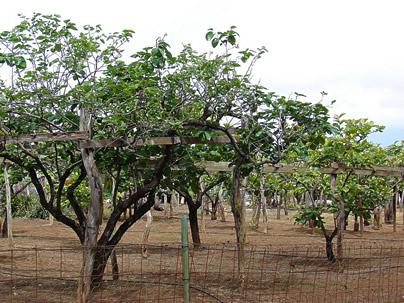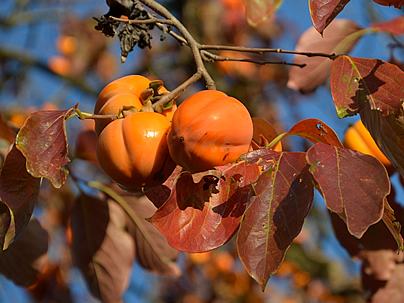The persimmon tree (Diospyros kaki) is an Asian-origin tree, dioecious, deciduous, and globally cherished for its sweet and flavorful fruits, the persimmons. The very botanical name Diospyros gives a good idea of a delightful fruit. The word comes from ancient Greek, meaning “food of Zeus”, an allusion to the divine taste of this fruit.
Its trunk is twisted, and the bark is quite rough, with deep and strong roots. Left to grow freely, it reaches 15 meters in height. However, in orchards, whether commercial or domestic, it’s not advisable to let it grow that tall, as it complicates harvesting. The leaves are broad, lanceolate, and rigid, and display an earthy green, lighter or darker, acquiring beautiful bronze and red hues in the autumn before falling.
The flowers are small, cream or pink-colored, tetrámeras, and can be female, male, or hermaphroditic. The flowering occurs in spring, and it’s possible for a tree’s sexual expression to change each year, with a higher proportion of male or hermaphroditic flowers, for example.
The fruits are berries and can have seeds if pollinated, or be completely seedless when formed by parthenocarpy. They can be globular, ovoid, or flattened, yellow to red, with thin skin and firm, opaque flesh, or soft, gelatinous, and translucent. The fruits mature in late summer and early autumn, but some harvests can extend a bit longer, depending on the cultivar. There are different varieties of persimmon trees, generally classified by the tannin content in the fruits, which can be:
- Sibugaki – Tannin-rich: Even when ripe, these fruits have a high tannin content, giving them a strong astringency in the mouth. The “tongue-tying” sensation is commonly described. The pulp is usually red. These fruits can be consumed safely, provided they undergo a destannization process, with ethyl alcohol, vinegar, or carbon dioxide, for about 4 days, making them sweet. Examples: Kakimel, Pomelo, Coral.
- Amagaki – Sweet (or non-tannin): With yellow or orange pulp, these are the persimmons that can be consumed while still firm, without astringency. The most well-known type of this group is Fuyu.
- Varieties – Here include the chocolate persimmon. The seeded fruits are sweet and non-tannin, with pulp more or less dark, with brownish streaks, varying with the number of seeds. The seedless fruits are tannin-rich, with yellow pulp, and need to undergo destannization like the sibugaki type fruits. Examples: Rama-forte, Giombo, and Kyoto.

Persimmons are mostly consumed in natura, but a myriad of culinary preparations can be made with them. From dried fruits (raisin type) to juices, jellies, liqueurs, puddings, ice creams, cakes, sauces (like chutney), and even excellent vinegar. They are rich in beta-carotene, vitamin C, and minerals, but also high in sugar and tannins, so their consumption should be moderate.
The persimmon is an excellent tree for the garden or home orchard, as it provides an abundance of fruits, ample shade in summer, and allows sunlight to pass through in winter. The persimmon tree is avidly sought by wild birds, both for the ample fruit supply and for nest building.
Its maintenance is low, and it’s mostly quite resistant to pests and diseases. It only requires pruning for shaping and fruiting, removing high, old, and diseased branches, opening the canopy for better air circulation and sunlight. Thinning the young fruits is also beneficial, as it allows for larger fruits and prevents tree exhaustion.
In commercial plantings, it’s important to follow recommendations for pruning, training, and propping branches, for optimal productivity and orchard health. Interesting fact: persimmon wood is similar to ebony, dark-colored, fine-grained, and hard. It’s difficult to work with but produces high-quality items, from golf clubs to musical instruments and household utensils.
The persimmon tree should be cultivated in full sun, in fertile, well-drained soil, enriched with organic matter, and irrigated regularly during the growth and fruiting period. In winter, it’s advisable to reduce or even suspend watering. It appreciates fertilizations rich in phosphorus and micronutrients, as well as liming carried out during the dormancy period, in winter.
During the vegetative period, fertilizations rich in nitrogen and potassium are welcome, applied in portions and without excess, otherwise, fruiting may be compromised. Despite adapting to different climates and enjoying warmth, the persimmon prefers subtropical climates, as it needs a certain amount of chill hours to flower and fruit satisfactorily. This time varies according to the cultivar. Thus, there are cultivars more suitable for planting in subtropical climates, others for temperate, as well as tropical.
Propagation is mainly through grafting of known productive clones onto resistant rootstocks, derived from seeds and adapted to either drier, deeper soils or shallower, moister soils, these being respectively Diospyros kaki and Diospyros virginiana. It bears fruit after 4 to 7 years of planting.


